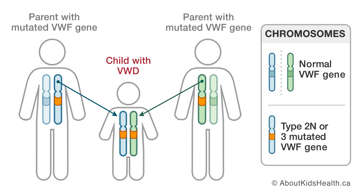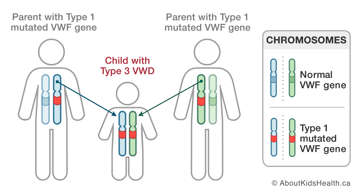What is von Willebrand disease?
Von Willebrand disease (VWD) is an inherited condition that affects the blood’s ability to clot effectively. It is a very common bleeding disorder that affects girls and boys equally.
When a person gets a cut, a type of cell in the blood called a platelet, and a protein called von Willebrand factor (VWF), stick to the wound to plug the cut. Proteins in the blood called clotting factors then bind together to form chains called fibrin. These chains then form a net around the platelets and VWF. This holds the clot together and helps to seal the wound.
In a person with VWD, there is either not enough VWF or it does not work properly. In either case, a blood clot cannot form properly, and the injured area will continue to bleed.
VWF also protects and maintains levels of clotting factor VIII, one of the proteins involved in blood clotting. Therefore, people with VWD may have low levels of factor VIII in addition to low levels of VWF.
Types and severity of von Willebrand disease
People with VWD have increased bleeding episodes depending on the severity of their disease. When they have a bleeding episode, they bleed for a longer period of time than a person without VWD.
There are several types of VWD: Type 1, Type 2 and Type 3. These vary in severity of symptoms and not all people will experience all symptoms. Some people will have minimal symptoms or have no symptoms at all.
| Diagnosis | Severity | Symptoms | |
|---|---|---|---|
| Type 1 | Low levels of VWF; may have slightly low factor VIII levels | Mild bleeding symptoms | Nosebleeds, mouth bleeds and heavy menstrual bleeding |
| Type 2 | Levels of VWF may be normal, but it does not work properly | Mild to severe bleeding symptoms | Same as in Type 1, but more severe; Type 2N can experience joint and muscle bleeds |
| Type 3 | Absent or extremely low levels of VWF; factor VIII levels will also be very low | Severe bleeding symptoms | In addition to Type 1 symptoms, will experience joint and muscle bleeds |
Type 2 subtypes
Type 2 VWD has four subtypes; treatment varies for each of these subtypes.
| Type 2 subtype | Description |
|---|---|
| Type 2A | This is the most common subtype. In this subtype, VWF does not work properly to bind platelets together. |
| Type 2B | In people with Type 2B, the VWF is “extra sticky” and it binds to platelets in the blood stream rather than at the site of the wound. This causes a shortage of platelets in areas where they are needed. Sometimes this type of VWD is misdiagnosed as a low platelet count such as idiopathic thrombocytopenia purpura (ITP). |
| Type 2N | In this subtype, the VWF binds to platelets at the site of the wound in the same way that it would in healthy people. However, while VWF normally transports clotting factor VIII, this does not occur in people with Type 2N. As a result, low levels of factor VIII lead to poor blood clot formation. Because of low levels of factor VIII, Type 2N VWD may be misdiagnosed as hemophilia. |
| Type 2M | In this subtype, VWF does not bind properly to platelets. This subtype is similar to type 2A but is distinguished through various specialized laboratory tests. |
Signs that your child may have von Willebrand disease
If your child experiences any of the following symptoms, you should talk to your doctor about the possibility that your child may have VWD:
- bleeding from the gums
- easy bruising
- prolonged bleeding after cuts or bloodwork
- frequent and prolonged nosebleeds
- blood in the stool or urine
- heavy or prolonged menstrual bleeding (menorrhagia) in girls
- soft tissue/joint bleeding (in more severe forms).
As VWD is usually inherited, it is possible that after a child in a family is diagnosed with VWD that other family members may be tested as well.
How is von Willebrand disease inherited?
VWD is a genetic condition and it is most often passed on from one or both parents to their children. Occasionally, VWD may occur when one of the child’s genes changes randomly; this is called a spontaneous genetic mutation.

The type of VWD depends on the mutation in the VWF gene. The parent may have mild symptoms or no symptoms at all. Types 1, 2A, 2B and 2M are usually inherited when one parent passes on the mutated VWF gene to their child.

Types 2N and 3 VWD are usually inherited when both parents pass on the mutated gene to their child. A child receives two mutated genes, one from each parent. Each parent may have only mild symptoms or have no symptoms at all.

Type 2N VWD occurs when a child inherits one Type 1 (or Type 2N) gene from one parent and one Type 2N gene from the other parent.

Type 3 VWD occurs when a child inherits a gene responsible for Type 1 VWD from both parents. In most (but not all) cases parents of a child with Type 3 VWD, despite having a gene for type 1 VWD, usually have normal levels of VWF and show no signs of bleeding.
Diagnosis of von Willebrand disease
While VWD has a genetic cause, VWF can also be affected by many other things such as blood type, age, stress, medications and hormone levels.
Often, the symptoms of Type 1 VWD are very mild. For this reason, it can take time to diagnose.
A diagnosis of VWD involves a series of blood tests measuring VWF levels and function as well as factor VIII levels in the blood. A physical exam, a review of family medical history and a bleeding questionnaire will also be performed.
Treatment of von Willebrand disease
Children diagnosed with VWD are cared for by a comprehensive team of health care specialists. This team will include a nurse co-ordinator, hematologist (blood doctor), physiotherapist, social worker, dentist and, for female teens and adults, a gynecologist.
Medications may be used to treat all types of von Willebrand disease
Tranexamic acid
Tranexamic acid is used to hold a blood clot together once it has already formed. It is often used when a person with VWD is undergoing a surgical or dental procedure, and for nosebleeds or mouth bleeds. For females, it can also be used for heavy periods.
Fibrin glue
Fibrin is the final product when a blood clot is formed. Fibrin glue is made up from several blood clotting agents. It is applied directly to wounds to stop bleeding. Fibrin glue is often used when people with VWD undergo surgical or dental procedures.
Desmopressin (DDAVP)
DDAVP is a chemical that helps to release factor VIII and VWF that is already stored in the blood. Before using this method, your child’s comprehensive care team will perform a “DDAVP Challenge”. This test is done to see if the use of DDAVP releases enough factor VIII and VWF in your child’s body to treat bleeds. If it does, your child is a "responder". Treatment of VWD with DDAVP is not recommended until your child is at least three years of age because of potential side effects. DDAVP does not work in some Type 2 subtypes and Type 3 VWD.
Von Willebrand factor product
Von Willebrand factor product is a plasma derived factor concentrate (a powder) that has been engineered from human plasma. It undergoes viral inactivation steps to make sure the product is safe. VWF product is used in more moderate or severe bleeds, to replace the VWF and FVIII in the body immediately to stop bleeding.
Treatment by type
Medical treatment of VWD will vary by patient, and should be discussed with your child’s healthcare team.
| Type of von Willebrand disease | Most common treatment options |
|---|---|
| Type 1 | DDAVP (if a responder); von Willebrand factor product |
| Type 2 | DDAVP (if a responder); von Willebrand factor product |
| Type 3 | von Willebrand factor product |
